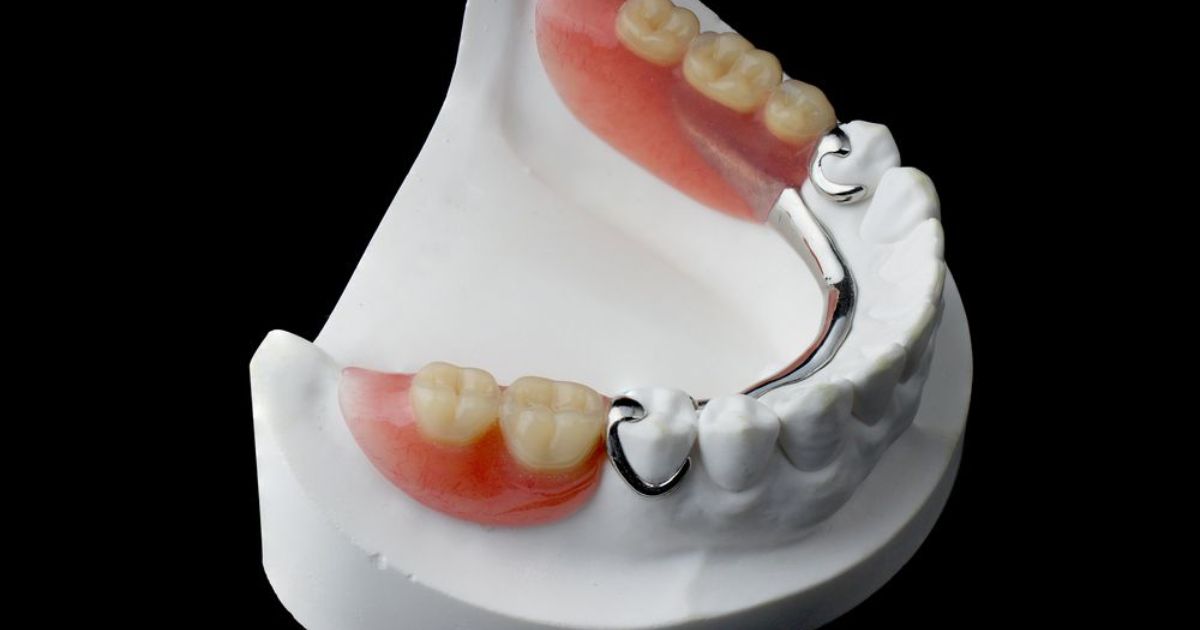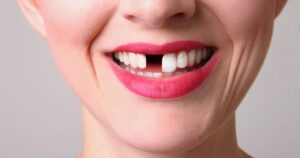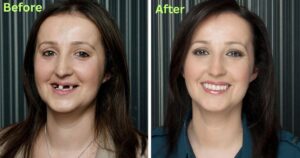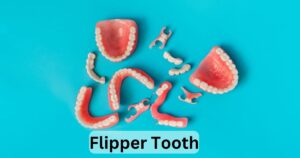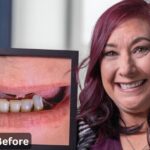Partial dentures serve as removable dental appliances used to replace missing teeth while preserving existing ones. These prosthetics consist of replacement teeth attached to a base made of acrylic or metal that matches the color of the gums. They’re tailored to fit comfortably in the mouth, held in place by clasps or attachments, ensuring stability and functionality.
These dental devices offer several benefits, enhancing aesthetics by filling gaps, improving chewing ability, and supporting facial structure by preventing adjacent teeth from shifting. Partial dentures also aid in speech, especially for individuals missing multiple teeth. Their removable nature allows for easy cleaning, maintaining oral hygiene.
Custom-made to suit each individual, partial dentures offer a cost-effective and non-invasive solution for restoring smiles and oral functionality. They play a vital role in enhancing oral health and confidence, catering to individuals seeking a reliable and comfortable option—especially for “affordable dentures and implants“—to replace missing teeth.
Types and Materials of Partial Dentures
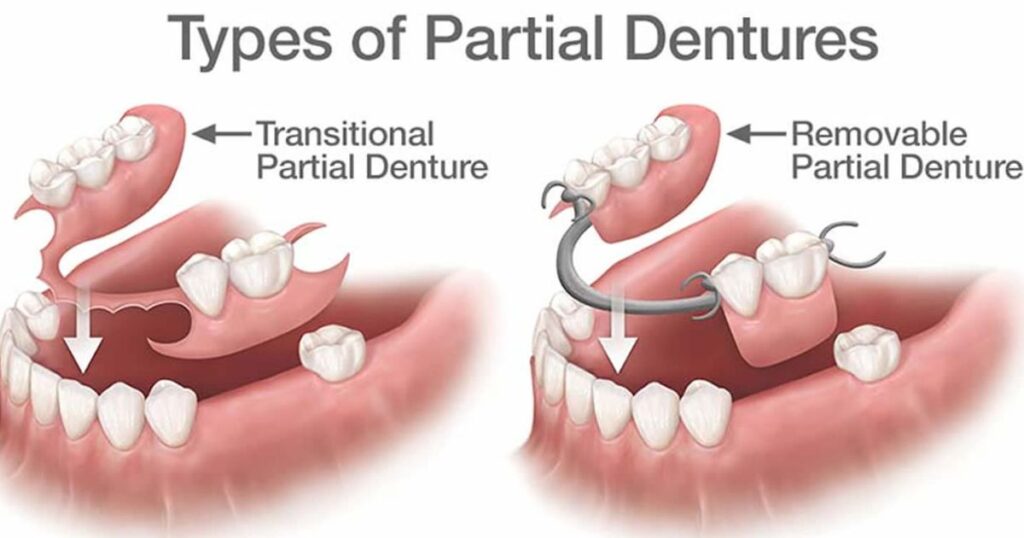
Partial dentures come in various types and materials, tailored to individual needs:
Cast Metal Partial Dentures
Cast metal partial dentures feature a durable cobalt-chromium alloy framework. These dentures offer strength, precision, and a secure fit. They are known for their lightweight nature and exceptional stability, providing reliable support to replace missing teeth. With their robust construction, cast metal partial dentures offer long-lasting functionality and are a preferred choice for individuals seeking durable and secure dental prosthetics.
Acrylic Partial Dentures
Acrylic partial dentures consist of artificial teeth set in an acrylic base that matches the gum color, providing a natural appearance. These dentures offer affordability and are relatively lightweight.
They are an accessible option for replacing missing teeth, although they may not be as durable as other materials. Acrylic partial dentures are easy to adjust and repair, making them a convenient choice for many seeking a cost-effective dental solution.
Flexible Partial Dentures
Flexible partial dentures feature a nylon-based base, providing a comfortable, discreet solution for tooth replacement. This flexible material adapts to mouth contours, offering a snug fit without metal clasps. Metal-free and lightweight, these dentures are less invasive and offer enhanced comfort.
Their flexibility ensures they blend seamlessly with the natural gum line, providing a cosmetically appealing and functional option for those seeking a discreet tooth replacement solution.
Hybrid Partial Dentures
Hybrid partial dentures blend durability and aesthetics, employing a combination of materials like acrylic and metal. These dentures prioritize strength while maintaining a natural appearance, offering a balance between durability and aesthetics. They utilize varied materials strategically to optimize both functionality and visual appeal, providing users with a reliable and cosmetically pleasing solution for tooth replacement.
The choice of material depends on factors like cost, durability, aesthetics, and the patient’s specific oral health needs. Dentists consider various aspects to determine the most suitable type and material for effective restoration and comfort.
Benefits of Partial Dentures
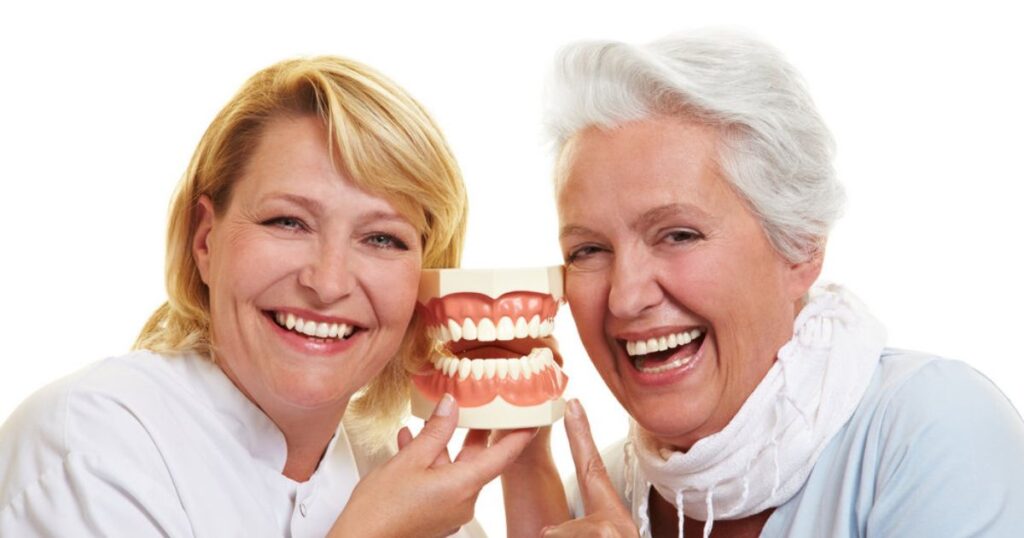
Absolutely, here’s a chart outlining the benefits of partial dentures:
| Benefits of Partial Dentures |
| 1. Improved Aesthetics |
| Fill gaps, enhancing smile and facial appearance. |
| 2. Enhanced Chewing Ability |
| Restore functionality for chewing and eating comfortably. |
| 3. Maintains Adjacent Teeth |
| Prevent adjacent teeth from shifting, preserving dental alignment. |
| 4. Speech Improvement |
| Aid in clearer speech, especially with missing teeth. |
| 5. Cost-Effective Solution |
| Provides an affordable option for tooth replacement. |
| 6. Easy Maintenance |
| Removable and easy to clean, promoting oral hygiene. |
| 7. Preserves Facial Structure |
| Supports facial structure by preventing bone loss. |
This chart highlights the multiple advantages of partial dentures, ranging from aesthetic improvements to functional restoration and cost-effectiveness, contributing to overall oral health and well-being.
Procedure and Fitting Process
The procedure for getting partial dentures involves several steps:
Consultation
During the consultation for partial dentures, a dentist evaluates oral health, discusses treatment options, and determines the most suitable denture type. This initial assessment involves understanding the patient’s needs, examining the mouth, and discussing factors like tooth loss, aesthetic preferences, and functionality requirements.
The consultation sets the foundation for the subsequent steps in crafting personalized and effective partial dentures tailored to the individual’s oral condition and preferences.
Impressions
Impressions involve taking molds or digital scans of the mouth to create a precise replica of the oral structures. These impressions serve as the foundation for crafting custom-fitted partial dentures.
Accurate impressions ensure the dentures fit comfortably and securely in the mouth, aiding in functionality and providing natural-looking results. This step is crucial in the denture-making process to ensure a tailored and comfortable fit for the patient.
Trial Fitting
During the trial fitting of partial dentures, a temporary model is placed in the mouth for assessment. This “try-in” stage allows evaluation of the denture’s fit, appearance, and bite.
Dentists and patients review the trial denture to ensure it feels comfortable and functions properly. Any necessary adjustments are made at this stage to achieve an optimal fit before the final fabrication of the partial denture.
Final Fitting
During the final fitting for partial dentures, the customized prosthetic is placed in the mouth to ensure proper fit and comfort. Dentists make necessary adjustments to achieve optimal functionality and appearance. This step allows individuals to experience how the denture will feel and function before finalizing the fabrication, ensuring a snug fit and addressing any concerns before the completion of the prosthetic.
Post-Fitting Care
During the final fitting for partial dentures, the customized prosthetic is placed in the mouth to ensure proper fit and comfort. Dentists make necessary adjustments to achieve optimal functionality and appearance.
This step allows individuals to experience how the denture will feel and function before finalizing the fabrication, ensuring a snug fit and addressing any concerns before the completion of the prosthetic.
This process ensures that the partial denture fits comfortably and functions effectively, restoring oral health and aiding in the natural appearance and functionality of the mouth.
Partial Dentures vs. Full Dentures: A Comparison
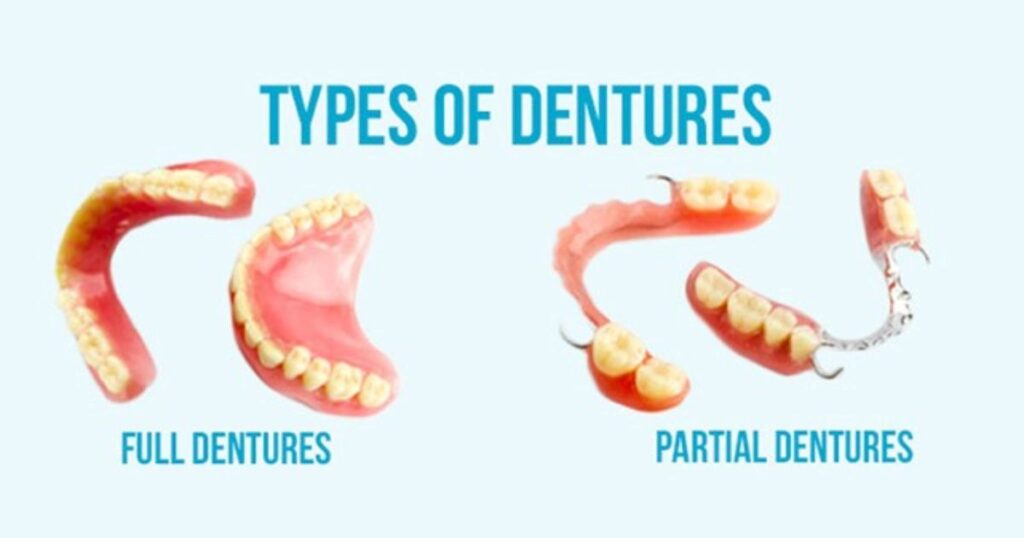
Certainly! Here’s a comparison chart between partial dentures and full dentures:
| Partial Dentures | Full Dentures |
| Replace some missing teeth | Replace all missing teeth |
| Rest on existing teeth and gums | Rest on gums without existing teeth |
| Require healthy adjacent teeth | Do not rely on adjacent teeth |
| Secured with clasps or attachments | Supported by gum suction or adhesive |
| More affordable | Costlier due to complete coverage |
| Easier adjustment period | Longer adjustment for full coverage |
| Partially restore facial structure | Fully restore facial appearance |
| Suitable for specific tooth loss | Suitable for complete tooth loss |
This chart illustrates the differences between partial dentures, designed for partial tooth loss, and full dentures, which replace all teeth. Understanding these distinctions helps individuals make informed choices based on their specific dental needs and preferences.
Partial Dentures Care and Maintenance

Proper care and maintenance are essential for ensuring the longevity and effectiveness of partial dentures:
Daily Cleaning: Remove dentures and gently brush them using a soft-bristled brush and mild denture cleaner or soap to eliminate plaque and food particles.
Handle with Care: Avoid dropping or bending dentures as they may break. Always handle them over a towel or filled sink to cushion against damage if dropped.
Soaking: Keep dentures moist by soaking them in a denture solution or water overnight to prevent drying out and maintain their shape.
Regular Rinsing: Rinse dentures after meals to eliminate debris and prevent staining.
Dental Check-ups: Schedule regular dental visits to have the dentures examined for fit, wear, and potential adjustments.
Oral Hygiene: Maintain oral hygiene by brushing natural teeth, gums, and tongue before reinserting dentures.
Avoid Harsh Cleaners: Refrain from using abrasive cleaners, hot water, or bleach, as they can damage the denture material.
Adhering to these care practices promotes oral hygiene, prevents damage, and ensures the comfort and longevity of partial dentures.
Adjustments and Follow-Up for Partial Dentures
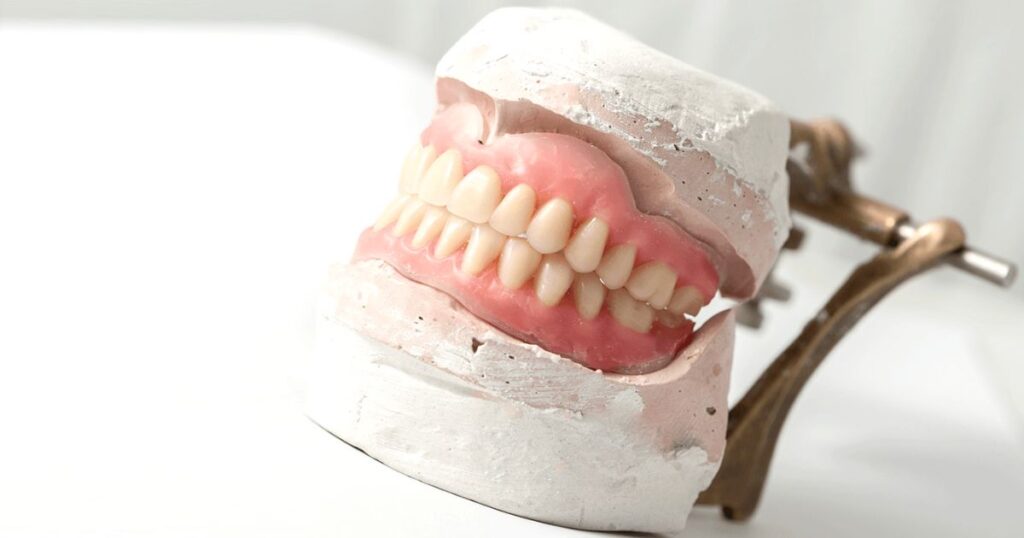
After receiving partial dentures, adjustments and follow-up visits are crucial for optimal comfort and functionality. Typically, adjustments might be necessary as the mouth adjusts to the new prosthetic. Dentists may refine the fit, ensuring the denture doesn’t cause discomfort or rubbing against the gums or adjacent teeth. These adjustments aim to enhance the denture’s stability and functionality, promoting natural chewing and speaking.
Follow-up appointments are vital to assess the denture’s fit and address any discomfort or concerns that may arise during wear. Dentists conduct regular examinations to ensure the denture remains snug and properly aligned, making necessary modifications for an improved and comfortable fit, contributing to the overall success of the prosthetic.
Partial Dentures: Cost Considerations
Cost considerations for partial dentures vary based on several factors. The overall expense may include the type of material used, the complexity of the denture design, and the number of teeth being replaced. Typically, partial dentures are more affordable than full dentures or implant-supported options.
Factors influencing costs:
Material Selection: Different materials carry varying costs. For instance, cast metal dentures might be more expensive than acrylic alternatives.
Customization: Highly personalized or intricate designs may incur higher costs due to the level of customization required.
Dental Insurance: Coverage or dental plans may offset partial denture expenses, reducing the out-of-pocket costs.
Additional Procedures: If preliminary treatments like extractions or oral surgeries are necessary, they can contribute to the overall cost.
Consulting with a dentist and discussing specific needs can provide a clearer estimate of partial denture costs, allowing individuals to make informed decisions aligning with their budget and oral health needs.
Enhancing Comfort with Partial Dentures
Partial dentures, tailored to replace missing teeth, offer a comfortable solution for improved oral function and aesthetics. They restore the ability to chew and speak naturally, contributing to overall comfort. Customized to fit the mouth’s unique contours, these prosthetics aim for a snug fit, reducing discomfort and allowing wearers to adapt seamlessly.
Regular adjustments and proper oral hygiene play pivotal roles in enhancing comfort. Adjustments address any discomfort or pressure points, ensuring a comfortable fit. Meanwhile, diligent oral hygiene routines. It includes cleaning the denture and mouth, prevent irritation or issues, optimizing comfort and longevity of wear.
FAQ’s
How many teeth do you need for a partial denture?
At minimum, you will need 1 or more teeth on each side, on each arch (top/bottom) — therefore we could say that 2 teeth per partial denture is a minimum. Realistically, a partial denture functions best with a minimum of 4 solid abutment (“anchor”) teeth.
How long do partial dentures last?
Partial dentures are ideal teeth replacement option, especially for those with a section of teeth missing. These oral appliances can last anywhere between 10 and 15 years.
Can you eat with a partial denture?
Yes, you can eat with a partial denture, but the experience (comfort + function) will vary depending on the type of partial and the number and location of teeth that you are missing. During the adjustment period, it will be necessary to consume softer foods and cut food into smaller pieces.
Are partial dentures painful?
It’s normal to experience discomfort with partials, especially in the first few weeks of wearing them. Your partials may feel awkward or bulky as you get used to them. You may also experience sore spots as your gums and mouth as you adjust to the new partial denture.
Can you wear partial dentures all day?
In general, it’s best to wear your partial dentures for around 8 hours every single day. This way, you are giving your jaw and gums a chance to get used to the dentures while also reducing the risk of developing sore spots. Generally, it’s recommended to remove your partial dentures before going to bed.
Conclusion
Partial dentures stand as versatile dental prosthetics, providing a cost-effective and comfortable solution for individuals with missing teeth. These appliances not only restore the aesthetics of a complete smile but also improve chewing ability and speech, contributing significantly to daily comfort and confidence.
Their custom-made nature ensures a tailored fit, aiming to reduce discomfort and enhance functionality. Regular adjustments and proper oral hygiene practices are key in maintaining comfort and maximizing the lifespan of these prosthetics. Moreover, their affordability compared to other tooth replacement options makes them an accessible choice for many seeking dental restoration.
Partial dentures bridge the gap between affordability and functionality, catering to diverse oral health needs. They play a vital role in restoring oral function and appearance, enabling individuals to regain their smiles and oral confidence, promoting overall well-being and quality of life.
